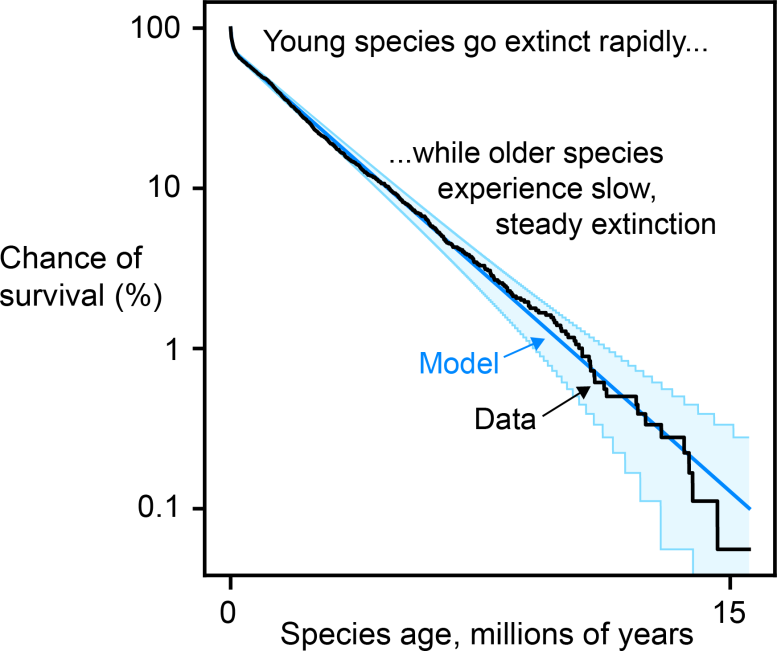A new study led by the University of Kansas might resolve a mystery in the “aging process” in species — or, how a species’ risk of going extinct changes after that species appears on the scene.
For years, evolutionary biologists believed older species lacked any real advantage over younger ones in avoiding extinction — an idea known as “Red Queen theory” among researchers.
Revisiting the Red Queen Theory
“The Red Queen theory is that species have to keep running just to stay still, like the character in Lewis Carroll’s book ‘Through the Looking-Glass,’” said lead author James Saulsbury, a postdoctoral researcher in the Department of Ecology & Evolutionary Biology at KU. “This idea was turned into a kind of ecological theory in the 1970s in an attempt to explain an observation that extinction risk didn’t seem to change over the lifespan of species.”
Yet the years have not been kind to this theory.
“In the earliest investigations of this phenomenon, species of all ages seemed to go extinct at about the same rate, perhaps just because of the relative crudeness of the evidence available at the time,” Saulsbury said. “This made sense under this Red Queen model, where species are constantly competing with other species that are also adapting alongside them.”
Questioning and Beyond the Red Queen
But as more data was collected and analyzed in more sophisticated ways, scientists increasingly found refutations of Red Queen theory.
Younger species are generally at greater risk of extinction. A new model from the University of Kansas shows this newer finding of age-dependent extinction while also emphasizing the importance of zero-sum competition in explaining extinction, as in the older Red Queen theory. Credit: Saulsbury et al
“Scientists kept finding instances where young species are especially at risk of extinction,” Saulsbury said. “So we had a theory vacuum – a bunch of anomalous observations and no unified way of understanding them.”
But now, Saulsbury has led research appearing in the Proceedings of the National Academy of Sciences that may resolve this mystery. Saulsbury and his co-authors showed the relationship between a species’ age and its risk of going extinct could be accurately predicted by an ecological model called the “neutral theory of biodiversity.”
Neutral Theory’s Insights
Neutral theory is a simple model of ecologically similar species competing for limited resources, where the outcome for each species is more or less random.
In the theory, “Species either go extinct or expand from small initial population size to become less vulnerable to extinction, but they are always susceptible to being replaced by their competitors,” according to a lay summary of the PNAS paper. By extending this theory to make predictions for the fossil record, Saulsbury and colleagues found that neutral theory “predicts survivorship among fossil zooplankton with surprising accuracy and accounts for empirical deviations from the predictions of Red Queen more generally.”
Saulsbury’s co-authors were C. Tomomi Parins-Fukuchi of the University of Toronto, Connor Wilson of the University of Oxford and the University of Arizona, and Trond Reitan and Lee Hsiang Liow of the University of Oslo.
While neutral theory might seem to spell curtains for the Red Queen theory, the KU researcher said the Red Queen still has value. Mainly, it proposes the still valid idea that species compete in a zero-sum game against one another for finite resources, always battling for a bigger slice of nature’s pie.
“Red Queen theory has been a compelling and important idea in the evolutionary biological community, but the data from the fossil record no longer seems to support that theory,” Saulsbury said. “But I don’t think our paper really refutes this idea because, in fact, the Red Queen theory and the neutral theory are, in a deep way, pretty similar. They both present a picture of extinction happening as a result of competition between species for resources and of constant turnover in communities resulting from biological interactions.”
Relevance and Implications for Conservation
Ultimately, the findings not only help make sense of the forces that shape the natural world but may be relevant for conservation efforts as species face increasing threats from climate change and habitat loss around the globe.
“What makes a species vulnerable to extinction?” Saulsbury asked. “People are interested in learning from the fossil record whether it can tell us anything to help conserve species. The pessimistic side of our study is that there are ecological situations where there isn’t a whole lot of predictability in the fates of species; there’s some limit to how much we can predict extinction. To some extent, extinction will be decided by seemingly random forces — accidents of history. There’s some support for this in paleobiological studies.”
He said there has been effort to understand predictors of extinction in the fossil record, but not many generalities have emerged so far.
“There’s no trait that makes you immortal or not susceptible to extinction,” Saulsbury said. “But the optimistic side of our study is that entire communities can have patterns of extinction that are quite predictable and understandable. We can get a pretty good grasp on features of the biota, like how the extinction risk of species changes as they age. Even if the fate of a single species can be hard to predict, the fate of a whole community can be quite understandable.”
Saulsbury added a caveat: It remains to be seen how broadly the neutral explanation for extinction succeeds across different parts of the tree of life.
“Our study is also working on the geological timescale in millions of years,” he said. “Things may look very different on the timescale of our own lifetimes.”
Reference: “Age-dependent extinction and the neutral theory of biodiversity” by James G. Saulsbury, C. Tomomi Parins-Fukuchi, Connor J. Wilson, Trond Reitan and Lee Hsiang Liow, 27 December 2023, Proceedings of the National Academy of Sciences.
DOI: 10.1073/pnas.2307629121
News
Scientists discover cancer-fighting bacteria that ‘soak up’ forever chemicals in the body
A family of healthy bacteria may help 'soak up' toxic forever chemicals in the body, warding off their cancerous effects. Forever chemicals, also known as PFAS (per- and polyfluoroalkyl substances), are toxic chemicals that [...]
Johns Hopkins Researchers Uncover a New Way To Kill Cancer Cells
A new study reveals that blocking ribosomal RNA production rewires cancer cell behavior and could help treat genetically unstable tumors. Researchers at the Johns Hopkins Kimmel Cancer Center and the Department of Radiation Oncology and Molecular [...]
AI matches doctors in mapping lung tumors for radiation therapy
In radiation therapy, precision can save lives. Oncologists must carefully map the size and location of a tumor before delivering high-dose radiation to destroy cancer cells while sparing healthy tissue. But this process, called [...]
Scientists Finally “See” Key Protein That Controls Inflammation
Researchers used advanced microscopy to uncover important protein structures. For the first time, two important protein structures in the human body are being visualized, thanks in part to cutting-edge technology at the University of [...]
AI tool detects 9 types of dementia from a single brain scan
Mayo Clinic researchers have developed a new artificial intelligence (AI) tool that helps clinicians identify brain activity patterns linked to nine types of dementia, including Alzheimer's disease, using a single, widely available scan—a transformative [...]
Is plastic packaging putting more than just food on your plate?
New research reveals that common food packaging and utensils can shed microscopic plastics into our food, prompting urgent calls for stricter testing and updated regulations to protect public health. Beyond microplastics: The analysis intentionally [...]
Aging Spreads Through the Bloodstream
Summary: New research reveals that aging isn’t just a local cellular process—it can spread throughout the body via the bloodstream. A redox-sensitive protein called ReHMGB1, secreted by senescent cells, was found to trigger aging features [...]
AI and nanomedicine find rare biomarkers for prostrate cancer and atherosclerosis
Imagine a stadium packed with 75,000 fans, all wearing green and white jerseys—except one person in a solid green shirt. Finding that person would be tough. That's how hard it is for scientists to [...]
Are Pesticides Breeding the Next Pandemic? Experts Warn of Fungal Superbugs
Fungicides used in agriculture have been linked to an increase in resistance to antifungal drugs in both humans and animals. Fungal infections are on the rise, and two UC Davis infectious disease experts, Dr. George Thompson [...]
Scientists Crack the 500-Million-Year-Old Code That Controls Your Immune System
A collaborative team from Penn Medicine and Penn Engineering has uncovered the mathematical principles behind a 500-million-year-old protein network that determines whether foreign materials are recognized as friend or foe. How does your body [...]
Team discovers how tiny parts of cells stay organized, new insights for blocking cancer growth
A team of international researchers led by scientists at City of Hope provides the most thorough account yet of an elusive target for cancer treatment. Published in Science Advances, the study suggests a complex signaling [...]
Nanomaterials in Ophthalmology: A Review
Eye diseases are becoming more common. In 2020, over 250 million people had mild vision problems, and 295 million experienced moderate to severe ocular conditions. In response, researchers are turning to nanotechnology and nanomaterials—tools that are transforming [...]
Natural Plant Extract Removes up to 90% of Microplastics From Water
Researchers found that natural polymers derived from okra and fenugreek are highly effective at removing microplastics from water. The same sticky substances that make okra slimy and give fenugreek its gel-like texture could help [...]
Instant coffee may damage your eyes, genetic study finds
A new genetic study shows that just one extra cup of instant coffee a day could significantly increase your risk of developing dry AMD, shedding fresh light on how our daily beverage choices may [...]
Nanoneedle patch offers painless alternative to traditional cancer biopsies
A patch containing tens of millions of microscopic nanoneedles could soon replace traditional biopsies, scientists have found. The patch offers a painless and less invasive alternative for millions of patients worldwide who undergo biopsies [...]
Small antibodies provide broad protection against SARS coronaviruses
Scientists have discovered a unique class of small antibodies that are strongly protective against a wide range of SARS coronaviruses, including SARS-CoV-1 and numerous early and recent SARS-CoV-2 variants. The unique antibodies target an [...]






















